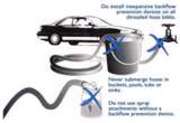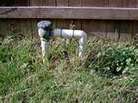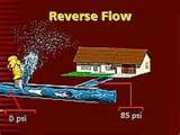What is Backflow and Cross-connections
Backflow and backsiphonage
A backflow prevention device is used to protect water supplies from contamination or pollution. Many types of backflow prevention devices also have test cocks so that they can be tested or examined to ensure that they are functioning properly. In the United States, the Environmental Protection Agency (EPA) holds local water suppliers responsible for maintaining a certain amount of purity in potable water systems. Many states and/or local municipalities require annual testing of backflow prevention assemblies. A check valve is a common form of backflow prevention.
Backflow prevention protects the potable water system from minor, moderate, and severe hazards. There are over 10,000 reported cases of backflow contamination each year. Some cases can be fatal. Backflow devices are required by law where needed and must be installed in accordance with plumbing or building codes. A backflow assembly has test cocks and shut-off valves and must be tested each year upon installation, relocation, or repair.
How often do you need to have your device tested?
TCEQ requires you to have a licensed BPA tester check the BPA when it is installed on your irrigation system. Your water provider may have adopted additional codes or regulations which require an annual test of the BPA on your irrigation system.
Garden Hoses and Backflow
The garden hose is the most common cross connection. Each of these common uses of a garden hose sets up a cross connection:
- forcing it into a clogged gutter, downspout, or sewer pipe to flush out the clog
- connecting it directly to a hose-end sprayer to apply pesticide or fertilizer to your yard
- connecting it to a soap-and-brush attachment to wash your car, boat, or siding
- letting the end of the hose lie in a puddle or pool of water on the ground
No doubt you can think of other examples. In each of these cases, if backflow happens, your household’s water lines could be contaminated. Depending on how long the backflow event lasts, the contamination could spread to the public drinking water system. Fortunately, there are two inexpensive ways to solve this problem:
- Make sure that the end of your garden hose is never become submerged in or connected to a nonpotable substance. This solution is free, but not highly reliable. Can you always be this careful?
- Install a hose bibb vacuum breaker on each of your outside faucets. These inexpensive devices are designed to allow water to flow in only one direction. You can find them at most home supply stores and through plumbing suppliers. Before you use a hose-end sprayer, you should first install a hose bibb vacuum breaker at the faucet.
How Cross Connection and Backflow Can Lead to Contaminated Water
It really happened in Texas:
- While mixing a batch of pesticide, a worker pushed a garden hose into the tank until it touched the bottom.
- Nearby, city utility workers opened a flush valve, releasing a large flow of water from a water main.
- Where the worker was mixing the pesticide, the water pressure dropped, and the flow in the hose reversed. Water and pesticides flowed from the pesticide tank back through the hose and into the water lines of his house.
Luckily, this is where it stopped: The worker mixing the pesticide realized the danger and alerted the utility workers, who closed the flush valve before the contamination reached the city’s distribution line. Still, good water and time were wasted:
- To remove the pesticide from the water lines of the customer, utility workers flushed those lines.
- In case the water main had been contaminated, the utility workers had to flush the city’s distribution line, too.
- Until testing showed authorities that the city’s water was safe, they warned customers in the area not to drink it.
The City of Corpus Christi as other cities in the coastal bend have adopted the International Plumbing Code which requires all backflow preventers to be tested upon installation and annually thereafter.
It's a good thing to have these devices tested, it's been documented that 15% of all backflows tested in Corpus Christi have failed and have had to be repaired or replaced.
DO YOU WANT TO BE THE PERSON THAT IS RESPONSIBLE FOR CONTAMINATING YOURS AND OTHERS DRINKING WATER? CALL TODAY TO HAVE YOUR DEVICE TESTED AND RECERTIFIED BY A LICENSED TESTER.
What is Backflow?
Elevated piping can cause backsiphonage when there is a loss of pressure in the supply system. The loss of pressure will cause the water column to collapse and create a vacuum that can draw contaminants in through a cross-connection (BMI, 1999; USC FCCCHR, 1993). Backsiphonage can also occur within irrigation systems. For example, in 1991, a water main break lead to the backsiphonage of parasitic worms from a residential lawn sprinkler supply into two homes (AWWA PNWS, 1995).
Booster pumps for high-rise buildings can cause backsiphonage if the suction lines of the pumps are being used for service on the lower floors and a temporary or permanent cross-connection on the lower floors exists (e.g., a hose submerged in a bucket of cleaning solution). If distribution system pressure drops, the suction pressure can cause the backsiphonage through the lower floor crossconnection when the pump is operating, contaminating the higher floors (BMI, 1999; USC FCCCHR, 1993; US EPA, 1989).
Localized physical restrictions in water lines can produce backsiphonage through the venturi effect (BMI, 1999). When water flows through a restriction—for example, through a garden hose or from a larger water line into a smaller one—its velocity increases and its pressure decreases proportionately (US EPA, 1989). This decrease in pressure can yield negative pressure and siphon substances into the point of restriction (BMI, 1999). Devices such as chemical sprayers used on the end of garden hoses use this principle to siphon chemical from the container into the water stream (BMI, 1996).
Backsiphonage can occur when supply piping within an industrial facility is elevated over the rim of a vessel, and the outlet of that piping is submerged in a liquid contaminant. Negative distribution system pressure would cause the water column in the elevated pipe section to collapse, creating a vacuum that draws contaminants from the vessel into the distribution system (BMI, 1999; USC FCCCHR, 1993).
If a pipe with cracks or leaking joints is exposed to a wet environment, negative pressure can cause water to be drawn in (or to intrude into) the distribution system through backsiphonage (Kirmeyer et al., 2001).
Cross-Connections
Plumbing cross-connections, which are defined as actual or potential connections between a potable and non-potable water supply, constitute a serious public health hazard. There are numerous, well-documented cases where cross-connections have been responsible for contamination of drinking water, and have resulted in the spread of disease. The problem is a dynamic one, because piping systems are continually being installed, altered, or extended.
Control of cross-connections is possible, but only through thorough knowledge and vigilance. Education is essential, for even those who are experienced in piping installations fail to recognize cross-connection possibilities and dangers. All municipalities with public water supply systems should have cross-connection control programs. Those responsible for institutional or private water supplies should also be familiar with the dangers of cross-connections and should exercise careful surveillance of their systems.
Backsiphonage at its worst
Do not use cheap backflow devices to protect your potable water system.


